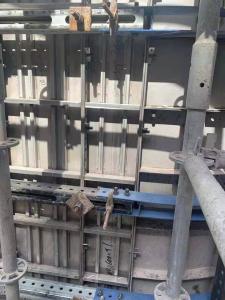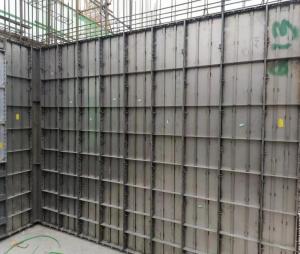High quality column steel formwork,metal formwork, Stainless Steel Formwork
- Loading Port:
- Shanghai
- Payment Terms:
- TT or LC
- Min Order Qty:
- 1 set
- Supply Capability:
- 1000000 set/month
OKorder Service Pledge
OKorder Financial Service
You Might Also Like
Stainless steel formwork
Replaceable size aluminum formwork :400X1200mm , 400X1500mm
PRODUCT SPECIFICATIONS
Panel thickness 120mm
Extremely strong and rigid
Fully compatible with Tricon system
Large size panels
Limited number of parts
High pressure resistance, minimum 100kn/m2
Long life expectancy
Stainless although magnetic sheets
Advantages:
1 Stainless steel formwork, 100% follow the design of aluminum alloy formwork system, it is interchangeable, compatible and can be used together with aluminum formwork at the same time .
2 (The maintenance of the floor or wall is simple and convenient, clean and smooth, easy to remove the mold, and the surface is beautiful.)
Integrated with the thermal insulation structure, the construction will be finished is fast, the efficiency is improved, no release agent is required, the wall has good flatness after de-moulding, no leveling is required, labor cost and time are saved . The construction speed of 5-6 floors a month shortens the construction period and saves Various expenses of the construction general contractor
3Long service life, many turnover times, high recycling value
The number of turnovers is large, especially the characteristics of no dust, no need to brush or less mold release agent, and the characteristics of low renovation costs will bring unlimited optimistic prospects to it.



- Q: How does steel formwork contribute to the overall structural integrity of a building?
- Steel formwork contributes to the overall structural integrity of a building by providing a strong and rigid framework for pouring concrete. It ensures accurate alignment and dimensional stability, resulting in consistent and reliable construction. The use of steel formwork also enhances the load-bearing capacity of the structure, allowing it to withstand heavy loads and external forces. Additionally, steel formwork offers excellent durability and longevity, reducing the risk of structural failures over time.
- Q: Can steel formwork be used for elevated concrete slabs?
- Yes, steel formwork can be used for elevated concrete slabs. Steel formwork is known for its strength and durability, making it suitable for supporting the weight and pressure of concrete during construction. It provides a stable and rigid framework for pouring and shaping concrete, ensuring the formation of high-quality elevated slabs.
- Q: What are the different types of safety systems used with steel formwork?
- Steel formwork commonly utilizes various safety systems to ensure worker safety and prevent accidents on construction sites. Some frequently employed safety systems for steel formwork comprise: 1. Guardrails: These are often positioned along the edges of the formwork to avert workers from slipping or falling. Constructed from steel or aluminum, they possess the capacity to withstand a specific amount of force. 2. Safety harnesses: Workers wear safety harnesses, which are fastened to a secure anchor point to prevent falls. These harnesses are typically adjustable to accommodate different body sizes and are crafted from robust, enduring materials. 3. Toe boards: Positioned at the bottom of the formwork, toe boards prevent the dislodgement of tools, materials, or debris from the structure. Usually made of plywood or steel, these boards are firmly affixed to the formwork. 4. Safety nets: Installed beneath the formwork, safety nets are capable of catching falling objects or workers in the event of an accident. Comprised of sturdy, flexible materials, they possess the ability to absorb the impact of a fall. 5. Ladders and stairs: Employed to facilitate secure access to and from the formwork, ladders and stairs are typically constructed from steel or aluminum, ensuring stability and durability. 6. Warning signs and barricades: Warning signs and barricades operate as cautionary measures, alerting workers and visitors to potential hazards and restricted areas. These items are usually manufactured using durable materials and are brightly colored for enhanced visibility. 7. Personal protective equipment (PPE): PPE, including hard hats, safety glasses, and steel-toed boots, is a vital safety system employed in conjunction with steel formwork. These protective measures are designed to safeguard workers against head injuries, eye injuries, and foot injuries. It is important to acknowledge that the selection of specific safety systems for steel formwork may vary depending on project requirements and regulations. Construction companies and workers must meticulously adhere to all safety guidelines and regulations to establish a secure working environment.
- Q: What are the different finishes available for steel formwork?
- There are several different finishes available for steel formwork, depending on the desired appearance and functionality of the final product. Some of the most common finishes include: 1. Smooth finish: This is the most basic finish option, where the steel formwork is left as is without any additional treatment. It provides a clean and simple appearance, but it may not be suitable for applications where increased durability or corrosion resistance is required. 2. Galvanized finish: Steel formwork can be hot-dip galvanized, which involves coating the surface of the steel with a layer of zinc. This finish provides excellent corrosion resistance, making it suitable for outdoor applications or structures exposed to moisture. 3. Powder coating: Powder coating is a popular finish option for steel formwork. It involves applying a dry powder to the surface of the steel and then baking it in an oven to create a durable and attractive finish. Powder coating provides excellent corrosion resistance and can be customized to achieve different colors and textures. 4. Epoxy coating: Epoxy coatings are commonly used in industrial settings where chemical resistance is required. These coatings create a protective layer on the steel formwork, making it resistant to chemicals, abrasion, and moisture. Epoxy coatings can also be customized with different colors and textures. 5. Paint finish: Steel formwork can be painted with various types of paint, such as enamel or latex, to achieve a desired appearance. Paint finishes provide some level of corrosion resistance, but they may not be as durable as other finish options. It is important to consider the specific requirements and conditions of the project when selecting the appropriate finish for steel formwork. Factors such as the intended use, exposure to elements, and aesthetic preferences should be taken into account to ensure the desired outcome.
- Q: What are the typical fire resistance ratings of steel formwork systems?
- The typical fire resistance ratings of steel formwork systems can vary depending on various factors such as the specific design, material thickness, and fire protection measures in place. However, steel formwork systems generally have fire resistance ratings ranging from 30 minutes to 120 minutes, providing adequate protection in case of fire incidents.
- Q: How does steel formwork handle formwork reuse and recycling?
- Steel formwork is highly durable and can withstand multiple uses without compromising its structural integrity. This allows for effective formwork reuse, reducing the overall cost and environmental impact of construction projects. Additionally, steel formwork is recyclable, making it a sustainable choice as it can be melted down and repurposed for future construction needs.
- Q: Can steel formwork be used for staircases and ramps?
- Yes, steel formwork can be used for staircases and ramps. Steel formwork is a versatile and durable option for creating complex shapes and structures. It provides the necessary strength and stability required to support the weight and loadings associated with staircases and ramps. Additionally, steel formwork can be easily assembled and disassembled, allowing for efficient construction and customization of staircases and ramps. Its flexibility also enables the creation of various designs and sizes to meet specific project requirements. Overall, steel formwork is a suitable choice for constructing staircases and ramps due to its strength, durability, versatility, and ease of use.
- Q: How does steel formwork impact the overall project execution?
- Steel formwork has a significant impact on the overall project execution in several ways. Firstly, steel formwork is known for its durability and strength, making it suitable for use in various construction projects. Its robust nature allows for multiple reuses, reducing the need for frequent replacements and lowering project costs. Additionally, steel formwork offers a high level of accuracy and precision in creating the desired shape and dimensions of concrete structures. This ensures that the final product meets the design specifications and minimizes any potential errors or defects. The ability to achieve precise and consistent results helps to streamline the construction process, saving time and effort. Furthermore, steel formwork provides excellent support and stability during the pouring and curing of concrete. Its rigid structure helps to prevent any deformation or displacement, ensuring that the concrete sets evenly and securely. This results in a structurally sound and stable finished product, enhancing the overall quality of the project. Moreover, steel formwork is versatile and adaptable, allowing for efficient customization to meet specific project requirements. It can be easily modified or adjusted to accommodate various shapes, sizes, and complexities of concrete structures. This flexibility enables contractors to work on projects with varying design specifications, reducing the need for multiple formwork systems and enhancing project efficiency. Lastly, steel formwork offers improved safety on construction sites. Its sturdy construction provides a stable working platform for workers, reducing the risk of accidents or injuries. Additionally, the use of steel formwork often requires fewer construction joints, resulting in a smoother and safer working environment. In conclusion, steel formwork plays a crucial role in the overall project execution by providing durability, accuracy, stability, versatility, and safety. Its impact extends beyond the construction phase, contributing to the long-term quality and success of the project.
- Q: What are the environmental benefits of using steel formwork?
- Using steel formwork for construction projects offers several environmental benefits. Firstly, steel formwork is reusable and durable, resulting in reduced waste generation compared to traditional timber formwork. This reduces the demand for timber resources, leading to a decrease in deforestation and the preservation of natural habitats. Moreover, the longevity of steel formwork means it has a longer lifespan, resulting in fewer replacements and less material consumption over time. Additionally, steel formwork can be easily recycled at the end of its life, reducing the burden on landfills and promoting a circular economy. Ultimately, the use of steel formwork contributes to sustainable construction practices, minimizing environmental impact and promoting resource efficiency.
- Q: How does steel formwork affect the overall acoustic properties of the structure?
- Steel formwork does not have a significant impact on the overall acoustic properties of a structure. However, it may slightly reduce sound transmission due to its dense and rigid nature compared to other formwork materials such as wood or plastic.
Send your message to us
High quality column steel formwork,metal formwork, Stainless Steel Formwork
- Loading Port:
- Shanghai
- Payment Terms:
- TT or LC
- Min Order Qty:
- 1 set
- Supply Capability:
- 1000000 set/month
OKorder Service Pledge
OKorder Financial Service
Similar products
Hot products
Hot Searches
Related keywords


























